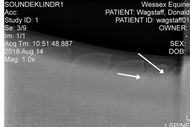Could it be Kissing Spine?
There’s surely nothing more heartbreaking for the owner of a horse than to have him living with low grade pain … the kind of pain that can be caused by the condition known as Kissing Spine.
Having experienced this with one of our own horses, it’s a subject close to our hearts here at Totally Tack and a condition we believe every horse rider should be aware of, lest it go unrecognised and the horse just accused of being “ornery”.

WHAT IS KISSING SPINE?
Kissing Spine occurs when the pieces of bone that project upwards from a horse’s spine – known as the dorsal spinous processes – become squashed together and begin to impact on each other, grating on each other and causing pain. The area under the saddle region is the one most affected, but it can happen anywhere along the back bone. Left undiagnosed and untreated it can become progressively worse. It generally affects large breed horses (especially Thoroughbreds) from the age of seven and up.
WHAT CAUSES KISSING SPINE?
While equine experts believe there may be a genetic component that makes a horse more at risk of developing the condition, it is also believed that being ridden with an ill-fitting saddle or a too heavy rider sitting incorrectly can contribute. Vets report that most of the horses treated for the condition are performance and competition horses – especially eventing horses – probably because of the physical demands placed on them. It’s also not advisable to ride a horse when he is too young before his skeleton has fully developed at around Seven or Eight years old. Then, too, trauma might be the cause.
HOW TO RECOGNISE KISSING SPINE
If you know your horse well the first sign of Kissing Spine developing will be a change in behaviour, particularly when you tighten the girth, saddle up and mount. He will show signs of irritability, discomfort and pain, even rearing and bucking as the condition worsens. He will probably refuse jumps, and you will be able to feel the reluctance in his forward movement, especially in cantering, due to pain.
If and when you begin to suspect a problem, don’t delay. Call in a vet to conduct a thorough investigation. The vet will probably start by observing the horse being lunged and ridden under saddle. This will probably be followed up with X-rays of the spine, which may be sufficient to diagnose the condition, although there could be changes in the spine unrelated to Kissing Spine. Most equine vets will probably prefer to confirm the diagnosis with a nerve block test. This involves injecting a local anaesthetic into the nerves of the affected spinal area (a bit like an epidural in humans) that will deaden the pain for a time, allowing the vet to observe the horse being ridden or lunged pain free. If the horse shows improvement in this test, the diagnosis will be confirmed.
TREATMENT OF KISSING SPINE
The treatment of Kissing Spine can be complicated, and generally you can kiss goodbye to the days when your horse was a high performer. At best after treatment he will become a competent hacking horse. Depending on the severity of the condition when it is first identified a period of rest will be initially prescribed, followed by exercise on the lunge. Physiotherapy can help, and injections of corticosteroids can bring relief. Things like shock wave therapy are also employed, the aim being to stretch the spine. Surgery is also an option, becoming ever more popular as the science of medicine improves. This involves the removal of selected dorsal spinous processes and the resection of the ligaments between them. This can now be achieved by a “keyhole” surgical technique in a sedated standing horse.
A horse suffering with Kissing Spine need not be a “right off” … he can give you many years of pleasure as a best friend or companion/therapy horse. Keep him pain free and under a vet’s care, and you’ll enjoy him as much as we enjoy our Donald.



